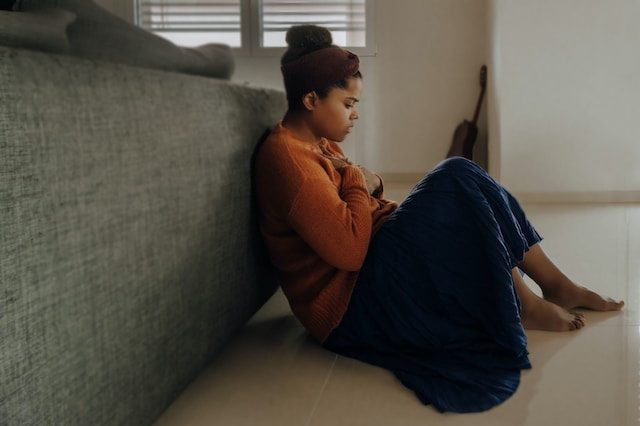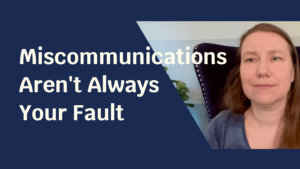When anxiety solutions create anxiety
Recently I was listening to a webinar on anxiety by someone I respect* and he was saying that anxiety is caused by an unmet need. That it’s a signal the body gives you when you need something. It might be hunger, company, or any number of things, and his solution was to recognize what the need is and to go fill the need.
I don’t entirely disagree with that, yet I think there are other causes of anxiety as well. But even when this is what’s going on, I don’t think it’s as simple as adding the thing you need. At least for some of us.
(I want to make a distinction here, because there are other facets of the Journey in which recognizing an underlying need and meeting that need (somehow) is exactly and entirely what is needed. I don’t think it’s that straightforward for anxiety, though.)
I do think there is a way out, but it involves a lot of working through the old wounds and painful beliefs before you can gain enough meaningful progress that straightforwardly fulfilling those needs reduces the anxiety.
Say you’re experiencing loneliness, and that’s creating anxiety. For people who, in their formative developmental years came to associate company with pain, or confusion, or self-doubt, or any number of negative feelings, fulfilling the need by adding people time can trigger those associations and exacerbate their anxiety rather than calming it.
Then it becomes this anxiety spiral, where you are lonely, but seeking company creates more anxiety, which reminds you of how lonely we are, which creates more anxiety, and so on.
I do think there is a way out, but it involves a lot of working through the old wounds and painful beliefs before you can gain enough meaningful progress that straightforwardly fulfilling those needs reduces the anxiety.
And that’s not even addressing the whole issue of how to know what your needs are, when that was something tamped down over decades so that now you don’t even know what you need (at least some of the time).
Digging deeper
These questions, about recognizing your needs and healing those old wounds and learning to work with anxiety in new ways, are some of the topics that I most frequently help my clients with, and that I’ll be addressing in the course on Autistic burnout recovery that I’m creating (they are much too big of topics to cover in a short format like this).
as you continue this Journey, find things that work better for you, and make choices that adapt or refuse general advice, and experience positive results, what you are doing is growing your capacity to trust yourself
So why did I bring this up without providing all the answers? Because I want to address the idea that these questions that we are dealing with – anxiety, unlearning neurotypical “shoulds,” and creating a genuinely autism-positive life – are not simple questions. These are complicated issues, with nuance, that require discernment and skill in navigating them.
While there are a lot of commonalities in peoples’ Journeys, if your situation doesn’t fit the standard model or idealized version or blanket answer that some professional provides (including me), it’s OK to adapt that answer or ignore it completely.
Trusting yourself is hard, complicated, and may be fraught with anxiety when you’ve been taught not to, but as you continue this Journey, find things that work better for you, and make choices that adapt or refuse general advice, and experience positive results, what you are doing is growing your capacity to trust yourself, to seek nuance, and to find your own better way.
And that, by the way, immensely reduces anxiety.
*I’m not going to name who, so as not to taint anyone’s view of him for what was not intended to be a nuanced answer, as I admire and respect his body of work a great deal.





2 Responses
Hey there! Just chiming in with my two-cents as a person who’s undergone DBT training for 3+ years, and continued to study and pursue psychology for longer than that.
“…He was saying that anxiety is caused by an unmet need. That it’s a signal the body gives you when you need something. It might be hunger, company, or any number of things, and his solution was to recognize what the need is and to go fill the need.”
This quote right here is the Textbook Definition of Emotions, in regards to DBT. In short, through DBT’s concepts, *all emotions* are messengers trying to tell us about what we need. If we are angry, that anger is trying to tell us we need something (maybe we are angry because it’s too hot, or maybe we are angry because we have just been offended.) Similarly, if we are sad, it again is a message telling us we need something. (We might be sad because of something that happened recently, and we need to grieve.)
Anxiety, too, is something that tells us what we need. But treating just like an emotion (to me) comparable to saying “Anxiety is just another emotion” and telling us to “resolve the need of the anxiety” in the same way that we might “resolve the need of being sad.”
But Anxiety isn’t as simple as that. Anxiety is not a base emotion, but rather a *reaction* to emotions. We feel antxiety *because* we are scared, hurt, or angry. Anxiety itself isn’t an emotion. And trying to treat it like one will ignore all those base emotions (fear, hurt, anger) that are the true messengers we so desperately need to look at and listen to with kindness and caring in our hearts!
I believe what you’re saying here is exactly similar to that:
“Say you’re experiencing loneliness, and that’s *creating* anxiety.”
> Loneliness is the emotion, and anxiety is the response.
“For people who, in their formative developmental years came to associate company with pain, or confusion, or self-doubt, or any number of negative feelings, fulfilling the need by adding people time can trigger those associations and exacerbate their anxiety rather than calming it.”
> Loneliness and Hurt from childhood are the messengers that need to be listened to and understood, rather than trying to just “fix” the anxiety by jumping into social situations.
I just wanted to put that out there for your consideration, and see if you think it helps makes this concept more approachable and understandable. All the best!
Thanks for chiming in! I completely agree with your elaboration. Emotions are excellent information about what we need, but anxiety isn’t a core emotion, rather a reaction to them.
Glad we’re on the same page. 🙂